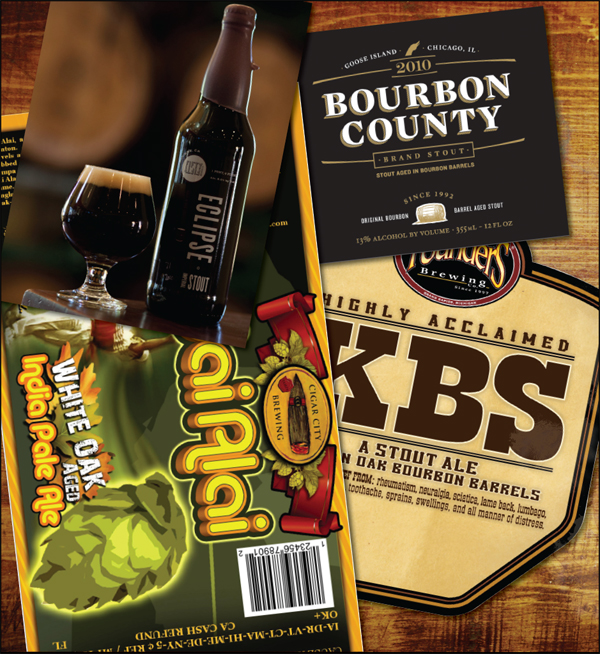


FROM FOREHEAD TO FEET, I’m a beer man to my marrow. I’ll choose beer over wine every day of the week, and a cocktail best be special to make me pass on a perfectly calibrated pale ale. But my drinking regimen is hardly rigid. At the end of a night, beer takes a backseat to an inch or two of bourbon or whiskey with a couple of cubes of ice to ensure that I’ll sip the spirit.
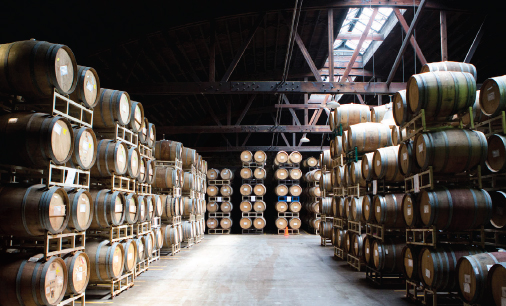
My tastes lean toward dry and spicy rye whiskeys such as Rittenhouse, and Sazerac, and soft, sweet wheated bourbons from W. L. Weller, Old Fitzgerald, and Pappy Van Winkle. Though each spirit has distinct merits, they all share a key trait: each one is aged in newly charred oak barrels. Inside the wood, a clear spirit undergoes a lengthy, mysterious process encompassing chemical reactions, oxidation, and flavor extraction from the wood. When a distiller deems the aging complete, the finished product is entirely dissimilar to the original spirit. I consider bourbon and whiskey proof that alchemy is real.
This process is not exclusive to liquor. Brewers also are tapping into the transformative magic of aging beer in oak barrels that once contained bourbon, though they’re just as likely to use a Chardonnay or rum barrel if it’s available. Wood is becoming another crucial ingredient in brewers’ bulging kitchen cabinets. On their endless mission for quirky new flavors, they’re using wooden barrels to season and spice their beers with a nuanced touch usually reserved for Michelin-starred chefs. Given time, barrels soften and revise beer, adding appealing notes of oak and extracting flavors left behind by the cask’s former inhabitant, which ranges from bourbon to sherry, Pinot Noir to aquavit.
When done right, barrel aging contributes complementary flavors that elevate beer to flavorful new heights. Read on to find out when bourbon and imperial stout became inseparable pals.
WOOD YOU KNOW?
Back when the telephone and the light bulb were barely a twinkle in people’s eyes, every ounce of beer in the United States and Europe was fermented and transported in wooden barrels. They were imperfect vessels. Although wood was excellent for containing liquid and could impart mellowing notes of vanilla and oak, it often harbored unwelcome colonies of bacteria and yeast that sometimes led to spoiled beer. (In Class 10, you’ll find that some brewers do want microbes to infect their beer.)
The issue of infection was solved when brewers began modernizing, swapping wood for stainless steel. In many respects, stainless steel is an ideal material. It adds no unwanted flavors to beer, and it’s largely nonreactive. Breweries can use chemicals and cleaners to scrub-a-dub-dub away undesirable microbes. If protocol is followed, beer should ferment according to plan. Stainless steel blazed the path for consistent mass-produced beer.
Now, however, brewers are turning their backs on progress and casting their eyes to a simpler, more unpredictable time. In every sense, this technique is a barrel of fun.

In 2012, the beer recommendation website Pintley launched one of the country’s more compelling barrel-aging projects. Called Oncemade, it tasks two Massachusetts breweries to produce a limited-run barrel-aged beer; the beers are packaged together in a hand-numbered wooden box along with two handmade wooden coasters, a signed letter from the brewers, and a piece of one of the barrels (oncemadebeer.com).

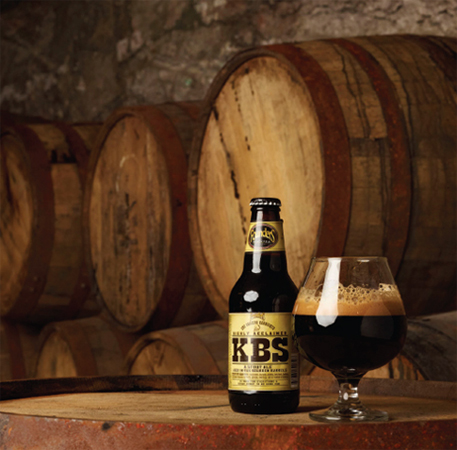
Founders Brewing’s bourbon barrel-aged KBS is regularly ranked one of the country’s best imperial stouts. Look for its release every April.
BOURBON, MEET BEER
A primary reason for this trend taking off is the hidebound bourbon industry. Legally, bourbon distilleries can use a new, freshly charred white-oak barrel only once. After the brown spirit is emptied out, the barrel is dumped onto the open market. Traditionally, many Maker’s Mark, Jim Beam, and Evan Williams barrels were exported to other distilleries, which used them to age tequila, rum, and even Scotch. Over the last several decades, breweries have begun buying used bourbon barrels. A few months or sometimes just a few weeks is all beer requires to ensnare the lush vanilla notes found in bourbon (and if the barrel was recently emptied, perhaps an alcohol boost as well).

Looking for a boozy breakfast treat? BLiS ages maple syrup in bourbon barrels, and Mikuni’s Noble Tonic 01 maple syrup slumbers in used barrels from New York’s Tuthilltown Spirits.

Not every beer is ripe for renovation. Lighter styles such as lager, pilsner, and kölsch will be dominated by the flavors of bourbon and oak. A better candidate for transformation is a stronger beer such as the heady tripel that Allagash ages in Jim Beam barrels until it becomes the Curieux. More commonly, bourbon and whiskey barrels are used for darker beers such as a brawny barley wine or a strapping imperial stout.
Today the coupling of bourbon barrels and beer is as commonplace as seashells by the seashore. In Louisville, Kentucky, it’s a no-brainer that Bluegrass Brewing matures its silky, smoky Bourbon Barrel Stout in spirit-soaked oak for 60 to 90 days. Founders Brewing consigns its chocolaty, coffee-infused KBS (Kentucky Breakfast Stout) to bourbon barrels and cave ages the concoction for a year. Adapting the formula to Scotland’s specialty, Harviestoun Brewery ages its Ola Dubh Special Reserve (aka “black oil”) in retired Highland Park single-malt Scotch whisky oak casks that are 12, 16, 30, or even 40 years old.

Goose Island’s Bourbon County has spawned numerous versions infused with everything from coffee to cocoa nibs, cherry bark, and even mouth-incinerating ghost peppers.

One of the first breweries to take advantage of this pairing was Chicago’s Goose Island. In 1992, that brewery was nearing its thousandth batch. To commemorate that milestone, head brewer Greg Hall dialed up a heavy-duty stout. It was dumped into used Jim Beam barrels and 100 days later was christened Bourbon County Stout. The inky, boozy potion defied categorization. Literally. At the 1992 Great American Beer Festival, the beer was disqualified for not adhering to any existing style. But what was once an anomaly has become a lauded style, spurring the creation of four distinct GABF categories: wood- and barrel-aged beer, sour beer, strong beer, and strong stout. Brewers’ ability to experiment with bourbon-drenched oak is as endless as the brown rivers of bourbon flowing from Kentucky.
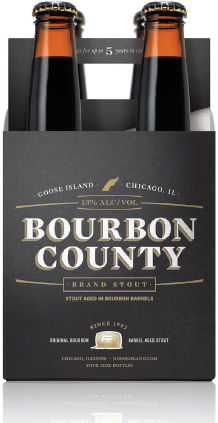

California’s Anderson Valley Brewing Company partnered with the bourbon makers at Wild Turkey Distillery to create an exclusive line of bourbon barrel–aged beers. The first release was the Barney Flats Oatmeal Stout aged for three months in a Wild Turkey barrel. Look for releases in bottles and on draft.

THE WIDE WORLD OF WOOD
Whiskey and bourbon barrels may dominate the barrel-aging sector, but they’re not the only available timber. Barrels used to season Chardonnay, brandy, rum, port, and Pinot Noir also have a built-in expiration date. As the flavors of vanilla and oak diminish each time a barrel is filled, a winery or distillery eventually must discard casks that have been drained of the desired essence. But a wine- or liquor-saturated cask could be the key breweries need to unlock a beer’s full potential.

Instead of going through the back-wrenching labor of filling barrels, some breweries use oak chips (occasionally soaked in a liquor of their choosing) or even spirals of unlikely woods such as cedar.

For its Window Pane series, North Carolina’s Mother Earth Brewing ferments a beer with local fruit (black-berries, figs, raspberries, peaches) and ages it for up to three months in used brandy, Chardonnay, or Pinot Noir barrels. In particular, Pinot Noir barrels have become a favorite of Oregon’s Oakshire Brewing, which makes one-offs such as the cherry-infused Cerise Noir and the scrumptiously tart Skookumchuck Wild Ale. (As you’ll learn in Class 10, breweries that dabble in wild or sour ales prefer old barrels because they’re perfect for cultivating colonies of microflora.) Care for some brandy? Try California-based Coronado Brewing’s honeyed Barrel-Aged Barley Wine or Captain Lawrence’s Golden Delicious tripel, which is aged in apple brandy barrels. Across the Atlantic Ocean in Norway, Haandbryggeriet (the “hand brewery”) finishes its Norwegian Porter in aquavit barrels.
Whatever your poison, you’re sure to find it soaked in oak.

Each barrel is as unique as a fingerprint and will create different characteristics. For the sake of uniformity, many breweries blend together different batches.


Tequila barrels are particularly tough to come by because distilleries in Mexico use them until they fall apart.

THAT’S THE SPIRIT

Whiskey starts life as a distiller’s beer, or wash, that’s made with malted barley, water, and yeast and then distilled and usually aged; hops are the only missing ingredient. Beer and whiskey cross paths again only atop a bar. Lately, though, brewers have begun pulling double duty as distillers and distillers have begun acting like brewers. In California, Anchor Brewing specializes in re-creations of vintage whiskeys. Michigan’s New Holland Brewing doses distillates with hops and offers a line of beer-inspired Brewers’ Whiskeys. Flipping the script, Nashville’s Corsair Artisan Distillery releases spirits based on recipes for imperial stouts, pumpkin ales, and even a witbier, and Sierra Nevada Brewing supplies the smoky brown ale that St. George Spirits of Alameda, California, transforms into single-malt whiskey.
Another tasty tributary of this trend involves distilleries sending bottle-ready beer through a still, putting a beer and a shot inside a single bottle. Germany’s G. Schneider & Sohn has its banana-noted Schneider Aventinus doppelbock distilled into Edelster Aventinus by the Schraml distillery. Japan’s Kiuchi Brewery turns Hitachino Nest White Ale into Kiuchi No Shizuku. The German brewery Uerige distills its strong brown ales Sticke and Dopplesticke, respectively, into Stickum and Stickum Plus. California’s Charbay distillery creates one of my favorite examples of this burgeoning category. Charbay sources Bear Republic’s Racer 5 IPA—one of my desert-island IPAs—and transforms the beer into Doubled & Twisted Light Whiskey and the aged R5 Hop-Flavored Whiskey. It’s heaven for hopheads looking to hit the hard stuff.

NINE KNOCKOUT WOOD-AGED BEERS TO TASTE
RESERVE SERIES HOP GOD
Nebraska Brewing Company
ABV: 10.1%
A hazard of aging beer in bourbon barrels is that oak and booze become the major players in the flavor game, overpowering the beer as easily as a pro wrestler does his fixed opponent. That’s hardly the case with this special version of Hop God, a citrusy Belgian IPA that spends six months sleeping in French oak Chardonnay barrels. The wooden slumber gives God luscious tannins, a tropical complexity, and a complementary vinous character. It’s heavenly.
DARK APPARITION
Jackie O’s Pub & Brewery
ABV: 10.5%
When I attended Ohio University in Athens in the late 1990s, O’Hooley’s was a ho-hum brewpub. But since then it has been rebooted as Jackie O’s, and brewmaster Brad Clark has made a national splash with his sour ales and barrel-aged behemoths, namely, the limited-edition versions of the chewy Dark Apparition Russian imperial stout aged in bourbon barrels. Clark regularly releases loads of other barrel-aged gems at the brewpub. A great time to visit is during Ohio Brew Week.
ECLIPSE
Fifty Fifty Brewing Co.
ABV: 9.5%
To facilitate the outsize demand for its imperial stout, this Truckee, California, brewery runs the Eclipse Futures program. It allows customers to place a 50 percent down payment to reserve a bottle—before the beer is bottled. Every batch of Eclipse, which debuts each December, is aged for at least six months in oak barrels that previously contained the likes of bourbons and whiskeys such as Rittenhouse Rye, Four Roses, Elijah Craig, and Buffalo Trace.
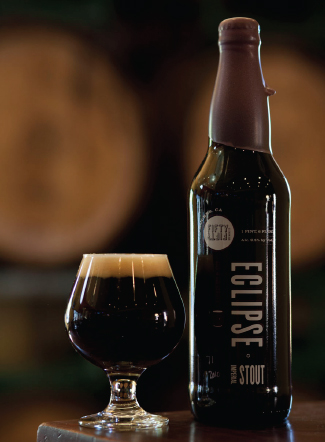
WOODCUT SERIES
Odell Brewing Company
ABV: Varies
In 2007, this Fort Collins, Colorado, brewery bought brand-new lightly charred oak casks from Canton Cooperage in Kentucky, kicking off its Woodcut Series. The focus is on drawing out the barrels’ natural tannins and subtle notes of vanilla. To date, Odell has debuted six Woodcuts, including a golden ale, a crimson ale, a double-strength märzen lager (the classic Oktoberfest beer), and a Belgian-style quadrupel.

BOXER’S REVENGE
Jester King Craft Brewery
ABV: 10.2%
Because of a handful of handcuffing laws, Texas fell behind the craft-beer curve. But a new crop of innovative breweries is catching up quickly, none more than the Austin-area Jester King. It makes excellent rustic ales such as the barrel-aged sour saison Das Wunderkind! and the farmhouse-style Black Metal imperial stout. Then there’s pugilistic Boxer’s Revenge: a potent “provision” ale (a specialty of farmhouse breweries near the Franco-Belgian border) aged in French oak wine barrels alongside multiple strains of Brettanomyces and fragrant Cascade, Columbus, and East Kent Goldings hops.
J SERIES
Two Brothers Brewing Co.
ABV: Varies
For its J Series, Illinois’s Two Brothers (Jim and Jason Ebel, the namesake Js) age their beers for four weeks in Frenchoak foudres—essentially, enormous wooden tanks. They add deep, complex flavors of vanilla and oak to two terrific offerings. The Long Haul Session Ale is a lightly malty all-day drinker (just 4.2 percent ABV), and the crisp honeyed Resistance IPA is suffused with pine, citrus, and oak that hangs out on the back end.
PALO SANTO MARRON
Dogfish Head Craft Brewed Ales
ABV: 12%
Never known to ride the easy route, Delaware’s Dogfish Head built a 10,000-gallon fermentation vessel from Paraguayan palo santo wood—the largest wooden tank built since Prohibition. The wood, which often is used by South American winemakers, adds scads of caramel and vanilla to this sweet, sticky, and roasty mahogany ale that glides down like maple syrup.
JAI ALAI AGED ON WHITE OAK
Cigar City Brewing
ABV: 7.5%
Wayne Wambles is wild for wood. The brewer at Tampa, Florida’s top brewery loves to experiment with unlikely lumber such as Spanish cedar and lemon and grapefruit wood, which can impart tart, sour characteristics. I dig the Jai Alai, a resinous and tropical IPA that’s altered by a brief but fruitful affair with white oak. It contributes a touch of drying tannic complexity, plus a hit of vanilla that harmonizes with the hop bitterness and, oddly, dill.

BIG WOODY BARLEYWINE
Glacier BrewHouse
ABV: 10.75%
If the Glacier BrewHouse were anywhere but Anchorage, Alaska, drinkers would write hymns to the glory of the brewery’s barrel-aged beers. Secreted beneath Glacier is a chilled vault housing “the Wall of Wood,” with oak casks from around the world containing at least 50 special-release beers, including tart lambic-style ales, oatmeal stouts, double IPAs, and Big Woody. Made with massive amounts of English barley, the deeply fruity and malty barley wine rests for at least a year in Jim Beam bourbon and Napa Valley wine barrels. It’s worth booking a flight to Alaska.
SIX FANTASTIC BARREL-AGED BEER FESTIVALS
WOOD WILL WIN YOU OVER AT THESE TOP OAK-SOAKED CELEBRATIONS.
FROM THE BARREL
Santa Margarita, California
To celebrate the anniversary of Prohibition’s end, Firestone Walker helps put on an event featuring tapas paired with the best American barrel-aged libations: Kentucky bourbon, wine from California’s Central Coast, and rare beers from the likes of The Bruery, New Belgium, and Ballast Point.
WEST COAST BARREL AGED BEER FESTIVAL
Hayward, California
Each fall, the Bistro (the self-proclaimed “home of extreme beer and live music”) hosts this celebration centered on BBQ, bands, and more than 60 barrel-aged beers. Bring friends so you can try them all.
FESTIVAL OF WOOD AND BARREL AGED BEER
Chicago, Illinois
Since 2003, the Illinois Craft Brewers Guild has hosted one of the largest American festivals dedicated to beer and wood. Expect more than 150 beers from coast to coast, with awards given in categories such as fruit beers, wild acidic beers, and strong porter/stout.
THE LITTLE WOODY BARREL-AGED BREW & WHISKEY FESTIVAL
Bend, Oregon
At this annual end-of-summer fest a roll call of Oregon’s finest brewers, including Deschutes, 10 Barrel Brewing, Ninkasi, and Oakshire, offer up one-off barrel-aged beers. For those that prefer the even stronger stuff, the festival offers a curated collection of small-batch spirits.
EXTREME BEER FEST
Boston, Massachusetts
The most popular session during the Beer Advocate crew’s annual ode to over-the-top beers is the Night of the Barrels, featuring more than 60 oak-aged rarities and a “wood panel” of renowned brewers.
STONE OAKQUINOX
Escondido, California
stoneworldbistro.com/oakquinox
Beer expert “Dr.” Bill Sysak curates this ludicrous collection of 100-plus rare beers from cultish breweries such as Kern River, The Lost Abbey, and Belgium’s 3 Fonteinen. The fun—gulp—starts at 10 a.m. You won't find a more extravagant collection of barrel-aged beers in America.
